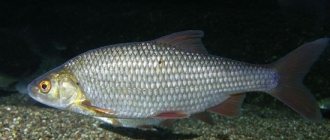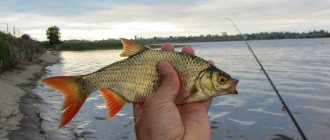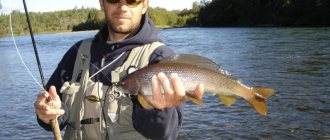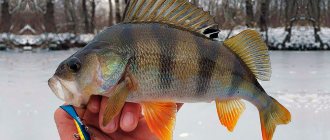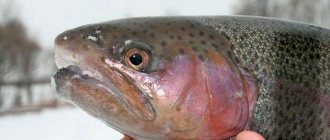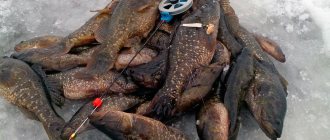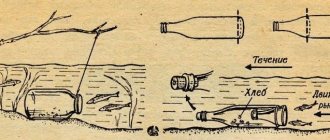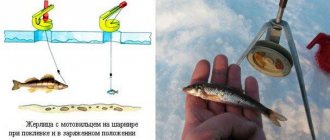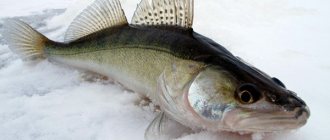The carp family has several dozen varieties, and not all of them are large in size and have tasty, valuable meat. The baby minnow fish is also included in this huge family. Catching minnows is a simple and interesting process that will bring considerable benefits, because you can easily stock up on valuable bait and go hunting for large predators.
Brief description of the species
The minnow lives in almost all bodies of water, but most often it is found in fast and cold rivers. A prerequisite for its life is clean, oxygenated water. The river variety of this fish differs in appearance from the lake variety. The river minnow is characterized by a silvery coloration, while the sides of its lake relative sparkle in shades of gold, and it also has more beautiful bright fins. Depending on the habitat, the colors may include other shades: lilac, reddish, yellow-green, gray.
This fish cannot boast of large sizes. It does not grow longer than 15 cm, and its maximum weight does not exceed 100 g. This species also has one interesting feature: females are somewhat larger than males.
Minnows lead a gregarious lifestyle. In summer, numerous schools of this fish are found on rifts, in places with rocky shores, in areas with vegetation and snags on the bottom. The minnow spends most of its time close to the surface, but this does not mean that catching it is as easy as bleak. Not at all. He is much more careful and timid, at the slightest noise he immediately hides in the depths and does not come out for a long time. On hot days, flocks move upstream in search of “fresh” water, and sometimes even leave the river for one of its colder tributaries.
Minnow propagation methods
It is known that readiness for the appearance of offspring occurs in this species by two years . In May, all individuals ready for spawning go to the places where they themselves were born. The fish gather in small schools. There are two times fewer males in these flocks than females. The spawning process lasts from May to July. The males swim up to the females and begin to squeeze them from several sides. Females that are not yet ready to spawn swim away. After the eggs fall into the water, the males fertilize them. The eggs stick to the underside of stones or algae.
It is known that during spawning, each female can produce up to a thousand eggs. The hatched larvae do not leave the space between the stones until autumn. At the beginning of winter they burrow into and remain there until spring. The fry leave the spawning site only in the spring. The average lifespan of a minnow does not exceed 5 years.
Time and place of fishing
The minnow is different from many other fish in that it does not have a specific feeding time. If he bites, he bites all day long, regardless of whether the sun is setting, rising or hanging overhead. Small individuals can be caught in the upper layers, but to catch large fish (in this case, more than 50 g), the bait must be lowered to the very bottom or try to feed it to medium depth.
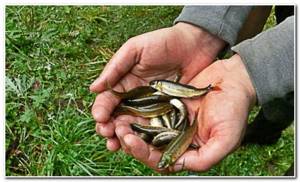
Shallow coastal waters with vegetation and submerged tree branches are most suitable for catching minnows from the shore. If experience does not allow you to fish in such places, then you can try fishing at the border of vegetation and clean water. When there are no bites for a long time, you should not expect the fish to approach. Perhaps something scared her, so she moved to the side. In this case, you should throw the tackle a few meters from the previous place.
Features of behavior and nutrition
The minnow is considered a rather aggressive fish . It is known to bite off the fins of larger species. It is constantly ready to attack smaller fish. If the prey is caught, the fish immediately eats it. This fish is able to spot prey at a great distance, as it has a good sense of smell and excellent vision.
The minnow feeds on small fish, worms and crustaceans. In addition, individuals consume larvae, pollen, algae fragments and plant seeds. In the days of mills, schools of fish tried to stay near them, as they fed on flour dust.
Best tackle for catching minnows
Most often, a sensitive, light and well-balanced float rod is used to catch this fish. There is no way to do without the last two characteristics, since you will have to hold it in your hand while fishing. The rod can be made of fiberglass or carbon fiber; even an antique bamboo product will do. The main thing is that it is comfortable and not too heavy.
A fishing rod for catching minnows is equipped with a thin fishing line (for example, 0.1 mm), a small hook (No2; 3), a miniature float and an appropriate sinker. In general, this is a very delicate tackle, quite suitable for the object being fished. Only with such a tool can you successfully catch these small fish. If you use a crude fishing gear, consisting of a heavy “stick”, thick fishing line and a carp hook, you may be able to catch several specimens, but how much the fisherman will suffer in this case, one can only guess.
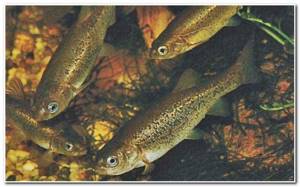
Minnow fishing
There are many types and methods of fishing known to avid fishermen, where it is impossible to do without proper skill and knowledge. For beginners, many of them are inaccessible, and this despite the abundance of useful tips and extensive information in specialized literature. Those whose first experience will be minnow fishing will be able to quickly become familiar with the mystery of the craft and boast of a good catch.
A small fish from the carp family has no commercial value and is most often used as live bait when catching larger predators (burbot, trout, pike, perch and others). It serves as their favorite treat and an important source of nutrition. The genus Phoxinus (minnows) includes more than 10 species. The distribution area covers the northern regions of Asia and almost all of Europe.
Fish, regardless of habitat, practically do not differ in weight and size. They have a wide body, an elongated caudal peduncle, a small head with a short blunt nose, a small mouth, and rounded fins. The average size of an individual is 10-12 cm, large specimens (found in lakes) grow up to 15 cm in length. The weight of one fish is in the range of 15-100 grams. Males are smaller than females and have a more intense color (especially during the spawning period).
The body of the minnow is covered with inconspicuous small scales. There are no scales on the belly. The palette of the main coating includes bright rainbow shades - golden, greenish-yellow, lilac, gray, red. The lateral line is black only reaching the middle of the body. The belly is white.
Despite the lack of an established fishery for this representative of the carp family, fishing for this fish in Russia, both in the European part and in the Siberian regions, is quite popular.
A distinctive feature of the two species under consideration is that the common minnow is caught along with other species, due to its small size, and lake minnow is caught by fishermen on the shores of lakes and reservoirs for food. One of the fishing methods is using a larger clay pot with holes drilled in the bottom, coated with dough on the sides from the inside.
Another quick way of fishing is using an old bucket, in which small holes are made around the entire perimeter (this must be done so that water from the bucket, if necessary, is quickly removed), put a crust of bread on the bottom of the bucket and place the bucket in places of accumulation so that There was about half a meter of water above it. After half an hour, you can check the catch, which will serve as live bait for fishing.
Lures
The minnow is famous for its omnivorous nature and always excellent appetite. He readily responds to any bait, regardless of its origin, be it animal food or plant food. That is why fishermen never have problems with attachments and baits for fishing this fish. There are worms and maggots - great, you can fish with them. Do you have any such living creatures with you? Then dough, bread crumb, or even a store-bought vanilla-scented bun will do. At worst, you can catch grasshoppers, which the minnow also does not refuse. As they say, he is small and daring, he absorbs everything.
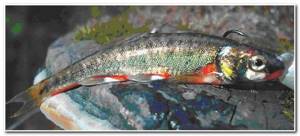
A few words about technology
As already mentioned, schools of minnows frolic and feed at the surface of the water, and go to the bottom only in moments of danger. If you can get close to them unnoticed, you can fish from the top, but if that fails, the depth should be increased. It is possible that the frightened fish will leave the area, then you will have to look for another promising place. This is not difficult to do, since an active minnow makes its presence known by light splashes on the surface.
It is advisable to hold the fishing rod in your hands. There are two reasons for this. Firstly, a rod lowered into the water will scare away the fish. Secondly, the bite of a minnow, due to its incredible greed for food, is lightning fast; even holding a fishing rod in your hands, it is not always possible to hook it in time. As a result, the hook with the nozzle ends up in his mouth so deep that without a special device it is not possible to get it out of there.
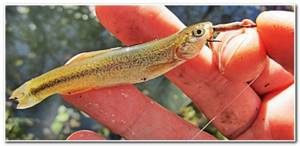
Another important point in fishing for minnows is casting the tackle. You need to cast the fishing rod so that the bait falls into the water as quietly as possible, without a loud “squelch.”
Habitat
The common minnow occupies the largest distribution area among all fish of this species. Habitat: Approximately all temperate regions of the world. For the most part it is found in reservoirs of more northern regions. The main habitats are lakes in river basins, reservoirs, small streams and cold rivulets.
The minnow prefers clean, freshwater water. It lives mainly in small fast-flowing rivers, well-aerated reservoirs, on rocky rifts; they choose places near aquatic vegetation, densely located one above the other in several rows, with larger fish located closer to the bottom, smaller ones on top.
Their numbers can be enormous. Due to the fact that the common minnow needs very clean, cool water with a high oxygen content, it does not live in dirty reservoirs. Those reservoirs where this species is preserved serve as a barometer of the ecological cleanliness of the reservoir. In reservoirs inhabited by predatory fish species, this fish serves as food.
The habitats of the lake minnow are often karst lakes, artificial reservoirs, quarries and peat bogs. It spends most of its life in the bottom layers, occasionally rising to the surface only in search of food.
It also happens: How to catch a chicken
It tolerates lack of oxygen in water without problems. This lively and attractive fish is not difficult to keep in a larger aquarium.
Advice
If you are a passionate hunter of large predators using live bait, but for some reason find yourself in a body of water without it, walk along the shore and carefully observe the shallow coastal waters. You will definitely find small minnows that are included in the diet of pike, perch, catfish, burbot, chub, and trout. It doesn’t take much time to catch them with a float tackle.
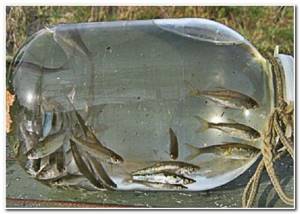
Description of the tiny fish where the babies are found
Minnow is a small fish that rarely exceeds ten centimeters in size. Babies 17-20 cm long can be considered trophy specimens; they are rare. The weight of the fish will not impress even the most undemanding fisherman - only 100 grams. Do babies have teeth? Like large predators, the fish have sharp, albeit small, teeth.
What does a minnow look like? The baby's body can be compared to a small spindle, slightly flattened on the sides. The color is variegated, the back is dark, and the belly is almost white, without scales. It is easy to distinguish individuals of the opposite sex - the fins of males resemble a chic fan, but those of females are narrow and rather short.
Minnows are found in almost every fresh body of water in Europe; the rivers and streams of Siberia are especially attractive to fish. Lakes with clear, clean water attract huge schools of fish, so hundreds of fishermen go here for live bait.
